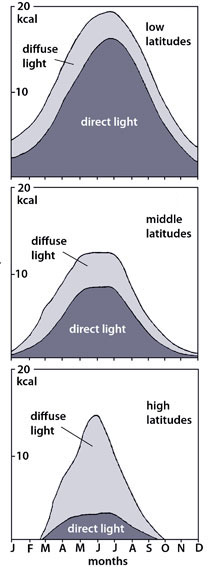The Lost World of the Arctic
| A Warm Arctic | Climate Change | Polar Light Regime | Paleo-Arctic Forests | Paleo-Arctic Fauna |
|---|
The Polar Light Regime
Because the Earth's rotational axis tilts, the sunlight received at the poles varies greatly throughout the year. The present day axial tilt (called obliquity) is approximately 23.4° from the vertical as measured from the orbital plane. The tilt changes over a period of 41,000 years and can be as little as 22.1° and as great as 24.5°. With the present day obliquity there is one day in mid winter above 66.6° (90°-23.4°) latitude when the sun never rises above the horizon and one day in mid summer when it never sets. The further towards the pole you go the longer the time the Sun doesn't rise in the winter and doesn't set in summer. At the pole the Sun stays below the horizon for 6 months and above for 6 months. The actual distribution of light at different latitudes in the Northern Hemisphere is shown below. The same light distribution applies equally to the Southern Hemisphere.
|
|||||||
This graph shows the variation in daylight throughout the year at different northern latitudes. For example, at 75°N there is approximately 1.5 months of continuous darkness begining near the end of November and ending around the middle of January. This is bounded by three weeks of twilight both in the fall and springtime. Between the middle of August and the beginning of November daylength decreases from 24 hours when the Sun never sets to 0 hours when it never rises above the horizon, but there is twilight. At the end of the first week in February the Sun again rises above the horizon and daylength increases until near the end of April when it stays above the horizon again for 24 hours. It does not dip below the horizon again until the middle of August. Modified from Anon. (1978).
|
|||||||
Light QualityIn addition to the distribution of light throughout the year the quality of light in terms of whether it is direct or diffuse also varies. The diagrams to the left illustrate the difference in light quality between the polar regions and that at lower latitudes. The polar regions experience a far greater proportion of daylight as not only low angle light but diffuse light scattered from the sky overhead. When the Sun is below the horizon (twilight) light is again scattered in the atmosphere providing diffuse illumination from the sky. Diffuse light is more efficient for photosynthesis than direct light (Mercado, et al., 2009). The Ancient Polar Light RegimeWe normally think of the rotational (geographic poles) as being roughly co-incident with the magnetic poles, but this need not be the case. During magnetic reversals the magnetic 'pole' migrates to near the opposite geographic pole, although during this change the field strength is thought to diminish before becoming stronger again after the reversal is complete. This reversal process has taken place many times throughout geological history but for most of the time the rotational and magnetic poles are roughly coincident. To examine if this was the case for the Maastrichtian Anne Lottes (Lottes, 1987) plotted the distribution of climatically sensitive sediments of that age, arguing that they should be symmetrical about the rotational pole because it is the rotational pole that affects climate. She found that they were centred on a position just 4° latitude away from the Maastrichtian magnetic pole. This suggest that for the Maastrichtian at least the rotational and magnetic poles can be thought of as the same, at least within the uncertainties in the positioning of both types of pole. This observation is consistent with the patterns in tree rings we find not just in the fossil woods of high latitudes in the Maastrichtian but throughout the Late Cretaceous and Paleogene. They show very fast transitions from full summer growth to winter dormancy. This is typical of the fast transition seen in the light regime, particularly above latitude 75°. Was the Cretaceous obliquity the same as now?We cannot be certain about the precise angle of obliquity at any point in time during the Late Cretaceous and Paleogene but it is possibe to calculate what it is likely to have been based on the work of the Scottish geologist James Croll (1821-1890) and the Serbian Milutin Milanković who was a geophysicist and civil engineer (1879-1958). The so-called Milanković-Croll cycles have been verified back into deep geological time by their application to what has become known as 'cyclostratigraphy'. Based on these observations, and with no known mechanisms for changing the obliquity outside its normal range of variation, we assume that the Cretaceous obliquity was within the normal range (i.e. between 22.1° and 24.5°). |
 |
||||||
Above: annual proportions of direct and diffuse sunlight at low, middle, and high latitudes after Shennikov, (1950). |
|||||||

